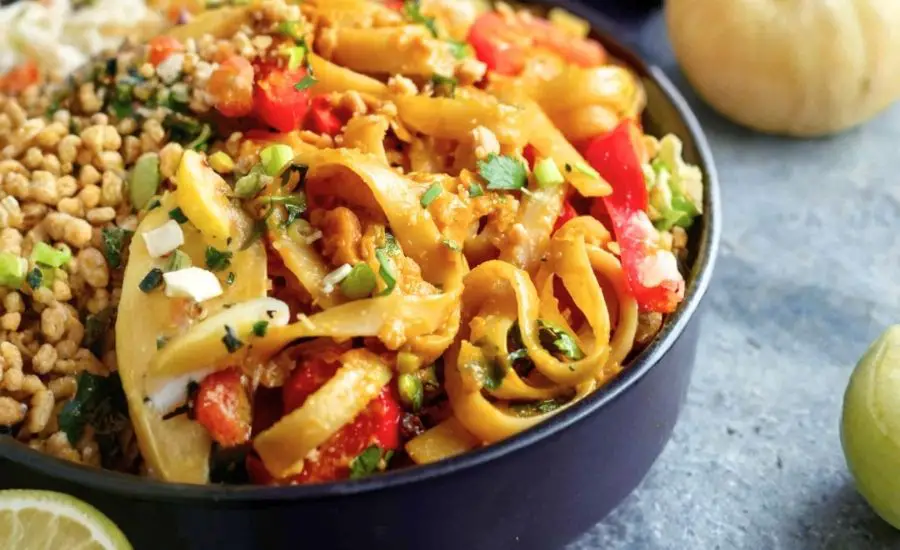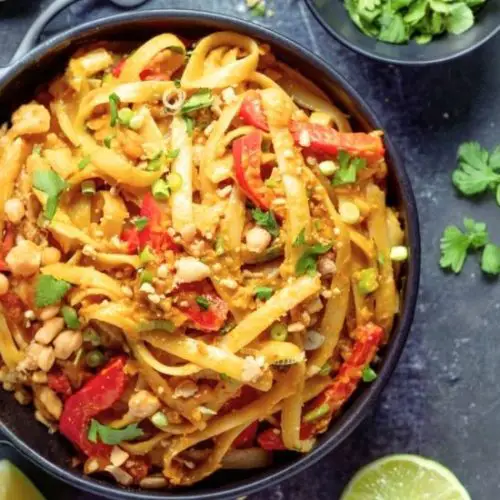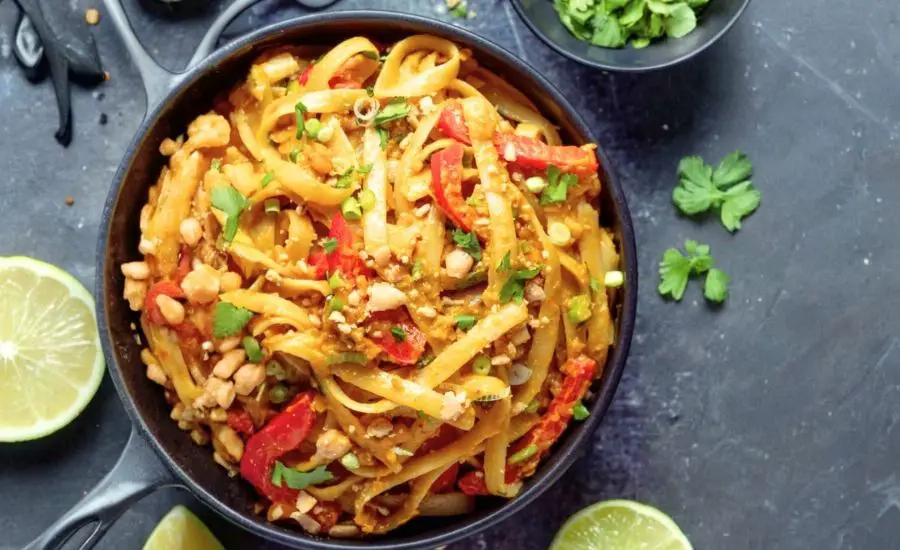All products are selected by our editorial team for quality. If you buy through our links, we may earn a small commission at no extra cost to you.
This Vegan Thai Peanut Noodles recipe stands out for its bold, authentic Thai-inspired flavors balanced with wholesome, plant-based ingredients.
It’s not only delicious but also nourishing—packed with fiber-rich veggies and plant-based protein from peanut butter, which also supplies healthy monounsaturated fats essential for heart health.
The light use of sesame oil adds a subtle nutty depth without heavy saturated fats, making it a guilt-free indulgence.
Ready in just 20 minutes, this dish is a perfect option for busy weeknights or meal prep, combining speed, simplicity, and satisfying textures.

Plus, the customizable noodles allow you to swap in gluten-free rice noodles or traditional spaghetti, catering to various dietary needs.
This recipe delivers both nutritional benefits and crave-worthy taste in one vibrant, colorful bowl.
Must-Have Tools for Perfect Results
Large Nonstick Skillet or Wok
Ideal for flash frying the veggies and tossing noodles with sauce, a quality wok or skillet ensures even heat distribution and easy cleanup. Its versatility extends beyond this recipe, perfect for stir-fries, sautéing, and more.
Measuring Cups and Spoons
Precision is key to balancing the peanut sauce flavors. Accurate measuring tools guarantee consistency every time, making them indispensable for any home cook.
Whisk
Use a whisk to effortlessly blend the peanut butter sauce until smooth and creamy. This simple tool prevents clumps and helps emulsify ingredients for a perfect silky texture.
Colande
Essential for draining cooked noodles quickly and thoroughly. A durable colander also aids in washing vegetables and draining pasta in countless other dishes.
Grater
Perfect for shredding carrots finely, a grater adds texture and freshness to the dish. Beyond this recipe, it’s useful for cheese, zest, and other veggies.

Vegan Thai Peanut Noodles
Equipment
- 1 Large Nonstick Skillet or Wok
- Measuring cups and spoons
- Whisk
- Colander
- Grater
Ingredients
Noodles:
- 8 oz 230 g fettuccine, spaghetti, rice noodles, or ramen noodles
Sauce:
- ½ cup smooth peanut butter preferably salted
- ¼ cup low-sodium soy sauce
- 1 tablespoon toasted sesame oil
- 2 tablespoons packed light brown sugar
- ½ tablespoon Thai red curry paste
- 2 tablespoons freshly squeezed lime juice
- 2 cloves garlic finely minced
- ¼ teaspoon red pepper flakes
- 4 tablespoons water
Vegetables and Garnish:
- 2 tablespoons sesame oil
- 1 large red bell pepper seeded and thinly sliced
- 1 large carrot grated
- ¼ cup roasted salted peanuts crushed
- ¼ cup chopped spring onions
- ⅓ cup fresh cilantro roughly chopped
- Lime wedges for serving (optional)
Instructions
- Cook the Noodles: Bring a large pot of salted water to a boil. Add your choice of noodles and cook according to package instructions, but slightly undercook them to maintain a firm texture. Once done, drain the noodles, rinse briefly under cold water to stop cooking, and set aside.
- Prepare the Peanut Sauce: In a medium bowl or measuring jug, combine the smooth peanut butter, soy sauce, toasted sesame oil, light brown sugar, Thai red curry paste, lime juice, minced garlic, red pepper flakes, and water. Whisk vigorously until you achieve a smooth, creamy sauce with no lumps. Adjust water to reach your desired consistency.
- Sauté the Vegetables: Heat sesame oil in a large nonstick skillet or wok over medium heat. Add the sliced red bell pepper and grated carrot. Stir-fry quickly for about 2–3 minutes until the vegetables soften slightly but still retain some crunch.
- Combine Sauce and Vegetables: Pour the prepared peanut sauce into the skillet with the vegetables. Stir well and cook for another 2 minutes, allowing the sauce to warm through and coat the veggies evenly.
- Toss Noodles and Garnish: Add the cooked noodles to the skillet. Gently toss everything together to combine, ensuring the noodles are fully coated with the sauce and mixed well with the veggies. Remove from heat and fold in crushed peanuts, spring onions, and cilantro.
- Serve and Enjoy: Dish out the noodles into bowls. Garnish with extra crushed peanuts, fresh cilantro, and lime wedges on the side for an extra zesty finish.
Notes
- Noodle Options: Feel free to swap noodles based on your preference or dietary needs—rice noodles or gluten-free options work wonderfully here.
- Spice Level: Adjust the amount of Thai red curry paste and red pepper flakes to suit your heat tolerance. For milder taste, reduce or omit the flakes.
- Make Ahead: The peanut sauce can be prepared a day in advance and refrigerated, making this dish a quick assembly meal.
- Protein Boost: Add tofu, tempeh, or edamame for extra protein and texture if desired.
- Storage: Store leftovers in an airtight container in the fridge for up to 3 days. Reheat gently to avoid drying out the noodles.
Chef’s Secrets for Flavorful Noodles
Achieving the perfect balance of bold flavors in this vegan Thai peanut noodle dish hinges on a few key techniques.
First, slightly undercooking your noodles ensures they stay tender yet firm when tossed with the sauce and vegetables—preventing a mushy texture.
Whisking the sauce ingredients thoroughly until completely smooth is essential to avoid clumps of peanut butter and to develop a creamy, luscious consistency.
When stir-frying, quick flashes of high heat soften the vegetables just enough while retaining their vibrant crunch and color, enhancing both texture and visual appeal.
Don’t hesitate to taste and adjust the sauce’s seasoning, balancing sweetness, saltiness, and acidity to your preference.
Lastly, fresh garnishes like cilantro, crushed peanuts, and lime wedges bring brightness and a satisfying crunch that elevate the dish to restaurant quality.
Serving Suggestions for Best Experience
This dish shines when served fresh and warm in individual bowls, making it perfect for casual family dinners or elegant weeknight meals.
Pair it with a crisp, light cucumber salad dressed in rice vinegar and sesame seeds to complement the rich peanut sauce and add a refreshing contrast.
For extra protein, consider grilled tofu cubes or pan-seared tempeh on the side. This recipe also pairs well with steamed edamame or simple miso soup for a balanced, satisfying meal.
Garnishing with extra cilantro and lime wedges allows guests to customize the flavor to their liking.
Because it’s colorful and packed with layers of texture, this dish is a feast for both the eyes and palate.
Storage Tips to Maintain Freshness
To keep your Vegan Thai Peanut Noodles tasting fresh, store leftovers in an airtight container and refrigerate promptly within two hours of cooking.
The dish can last well up to three days in the fridge.
When reheating, use a gentle stovetop toss or microwave on medium power with a splash of water to prevent the noodles from drying out or clumping together.
Avoid overheating, which can make the noodles tough and the peanut sauce separate.
If you prefer to meal prep, keep the peanut sauce separate from the noodles and vegetables until ready to serve.
This approach preserves texture and freshness, letting you assemble a delicious meal in minutes.
Frequently Asked Questions About Recipe
1. Can I use other types of noodles?
Absolutely! This recipe is versatile with fettuccine, spaghetti, rice noodles, or ramen. Choose your favorite or what you have on hand, and adjust cooking times accordingly.
2. How spicy is this dish?
The spice level depends on the amount of Thai red curry paste and red pepper flakes used. You can reduce or omit the flakes for a milder dish or add more for extra heat.
3. Is this recipe gluten-free?
To make it gluten-free, use rice noodles or gluten-free pasta and substitute tamari or gluten-free soy sauce. This swap keeps the dish flavorful without gluten.
4. Can I prepare this recipe ahead of time?
Yes! The peanut sauce can be made in advance and stored in the fridge. It’s best to toss the noodles and veggies with the sauce just before serving for optimal freshness.
5. What are some protein add-ins?
For a protein boost, add cubed tofu, tempeh, or edamame. These plant-based options complement the flavors and make the meal more filling.
This recipe is inspired by lovingitvegan and has been carefully refined to enhance clarity, streamline preparation steps, and ensure accurate results. We’ve also included health benefits, nutritional highlights, and Must-Have Tools to help you get the best results every time you cook.


